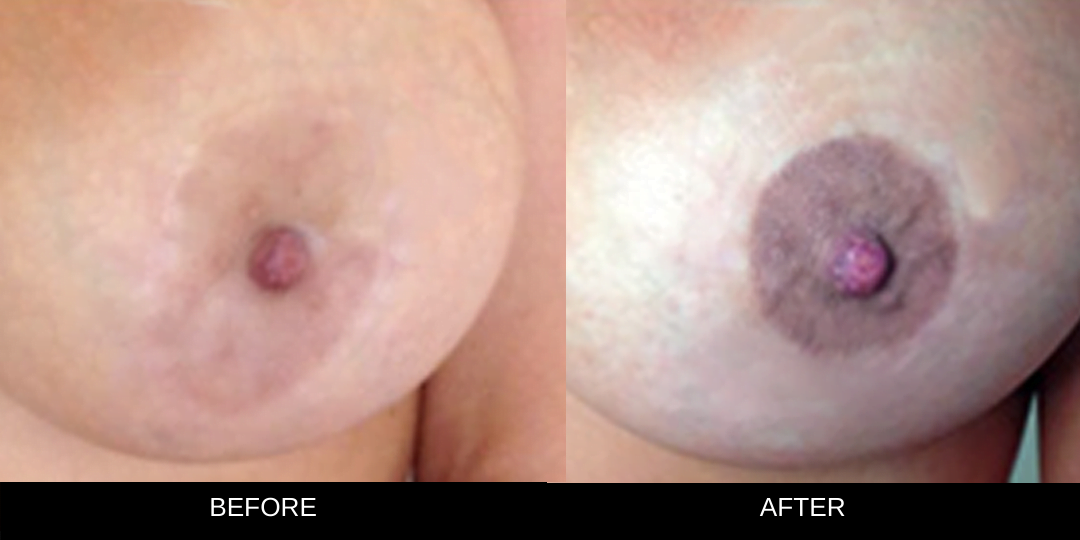
What is an areola and nipple correction?
An areola or nipple correction may be necessary when the areola is too large or when the nipples are retracted. The average areola is about 4,5 cm large and can be easily corrected by the plastic surgeon. This procedure is often done using a local sedative.
An oversized areola often coincides with sagging breasts. When you choose for a breast lift or breast reduction, it is often combined with an areola reduction. It is also possible to choose for an areola reduction without having any other surgery done.
What are the advantages of a nipple correction?
- No more oversized, asymmetric or retracted nipples
- Minor procedure using a local sedative
When am I a suitable candidate for a nipple correction?
Before the nipple correction can be performed, you will need to meet with one of our consultants. You can then indicate your wishes and expectations. The consultant will examine your breasts and give you his or her advice afterwards. He or she will also indicate which is the most suitable doctor for your procedure and best meets your needs.
Once this has been determined, you will be seen by the doctor who will perform the nipple correction. He will also examine your breasts and decide whether it is medically responsible to carry out the procedure.
The law in the Netherlands stipulates that there must be at least a 7-day waiting period between your consultation with the doctor and your operation date.
How is a nipple correction done?
An enlarged areola is surgically corrected by removing the pigmented skin around the nipple(areola). Our specialised doctors do this by making a small incision in the outside of the areola or around the nipple, which will leave a small scar. This procedure can be done perfectly well using a local sedative. The mammary gland and the milk ducts remain untouched making breastfeeding still possible after an areola reduction.
Enlarged nipples can also be made smaller, usually by removing a section of the milk ducts. An incision is made around the nipple and then through the milk ducts. The milk ducts in effect, pull the nipple inwards. Note it will no longer be possible to breastfeed after this treatment.
Should you still want to be able to breastfeed after this procedure, the plastic surgeon will need to know this. It is sometimes possible for him to choose a different method. Unfortunately, this does give less spectacular results, but the milk ducts remain undamaged.

Our specialists can also help you with retracted nipples. There are two different types of retracted nipples.
- The first type being the regular shaped retracted nipple that retracts on occasion. The plastic surgeon can prevent this by inserting a small ring just under the skin. When you have a regular shaped nipple, this is a quick and efficient procedure with no scarring. The milk ducts remain intact, and you can breastfeed with no problems.
- The second type being a poorly constructed, retracted nipple (this problem often starts in puberty). This type of nipple is more complicated to treat. The plastic surgeon makes an incision in the nipple to detach the milk ducts. This prevents the ducts from pulling the nipple inwards. You may experience crust formation for a few weeks after this procedure. Sometimes breastfeeding is no longer possible.
After your first consultation with your plastic surgeon, you will meet with our consultant. He or she will discuss the general affairs of your nipple correction.
*The doctor will determine if the treatment is necessary for medical reasons. * This treatment falls within the tax-exempt medical care as stated in article. 11-1-g Tax Law, 1968. NB: Payment for your treatment should be paid in full no later than four weeks in advance.
What can I expect after having had the nipple correction done?
The aftercare for a nipple correction is very important. You should take good care of yourself after the surgery. This will allow the wound to heal better and you will get better results.
The treated area will be swollen afterwards, and there may also be some bruising. These symptoms should go away after three days. A nipple correction is a relatively minor procedure allowing you to resume your daily activities quickly.
We recommend that you take plenty of rest the day after your procedure and that you do not engage in any heavy physical work. The treated area must not put under any strain. You should be able to go back to work after about two days.
But listen to your own body well. The scars can be very visible and fierce in colour for the first few months after the operation. However, the scars will eventually start to take on the colour of your skin. We always try to work as accurately as possible to make sure that the scars will be as small and discrete as possible.
Smoking
For a wound to heal beautifully, quickly, and as nicely as possible, it must get enough oxygen-rich blood flowing through it. That’s why we advise against smoking before the operation. The nicotine in the cigarettes narrows the blood vessels which in turn reduces the blood flow to the wound.
Not only that, but tobacco smoke contains carbon monoxide which restricts the amount of oxygen in your blood.
Finally, we would like you to be aware that smoking affects your condition and weakens your immune system.
All these factors increase the risk and frequency of complications in the healing process for those who do smoke rather than for those who don’t. We advise you to stop smoking at least four weeks before your operation and until at least two weeks afterwards.
AREOLA AND NIPPLE CORRECTION BEFORE & AFTERS



